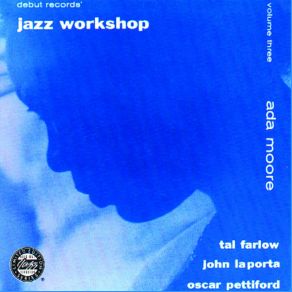Jazz Workshop, Vol. 3
Download links and information about Jazz Workshop, Vol. 3 by Tal Farlow, John LaPorta, Ada Moore. This album was released in 1954 and it belongs to Jazz, Vocal Jazz genres. It contains 11 tracks with total duration of 42:33 minutes.

|
|
|---|---|
| Artist: | Tal Farlow, John LaPorta, Ada Moore |
| Release date: | 1954 |
| Genre: | Jazz, Vocal Jazz |
| Tracks: | 11 |
| Duration: | 42:33 |
| Buy it NOW at: | |
| Buy on iTunes $9.99 | |
| Buy on Songswave €1.21 | |
Tracks
[Edit]| No. | Title | Length |
|---|---|---|
| 1. | The Man I Love | 4:50 |
| 2. | The Man I Love (Take 2) | 4:46 |
| 3. | Something to Live For | 5:24 |
| 4. | You Came a Long Way from St. Louis | 3:44 |
| 5. | You Came a Long Way from St. Louis (Take 4) | 3:57 |
| 6. | The Devil Is a Woman | 3:55 |
| 7. | The Devil Is a Woman (Take 1) | 4:10 |
| 8. | Lass from the Low Country | 2:33 |
| 9. | Lass from the Low Country (Take 2) | 2:31 |
| 10. | Strange Fascination | 2:04 |
| 11. | Summertime | 4:39 |
Details
[Edit]The focus of this 1954 set is a seldom-heard session that Ada Moore recorded for Charles Mingus' Debut Records label in 1954. The lineup is certainly nothing to complain about; Moore is joined by guitarist Tal Farlow, bassist Oscar Pettiford, and alto saxman John La Porta (among others), and Mingus helps with the arrangements. Moore has a soulful delivery that is somewhere between Carmen McRae and Sarah Vaughan, although Jazz Workshop, Vol. 3 is more abstract than what either of them were doing in 1954. The arrangements combine jazz with European chamber music, and Moore's risk-taking pays off on material that ranges from "The Man I Love" and Billy Strayhorn's "Something to Live For" to the folk song "Lass from the Low Country." Meanwhile, "The Devil Is a Woman" is a moody Moore original that almost sounds like a combination of "Black Coffee" and "Blues in the Night." Like much of the music that the Modern Jazz Quartet was providing at the time, Jazz Workshop, Vol. 3 manages to be classical-influenced without sacrificing the feeling of the blues. This session didn't do much for Moore commercially, but it's worth checking out if you appreciate the third stream experiments of the 1950s.